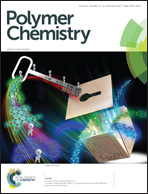Tunable charge transfer effect in poly(spirobifluorene)s with different electron-rich side chains†
Abstract
A series of blue-emitting poly(spirobifluorene)s (PSFs), namely, Cz-PSF, 4RO-PSF and DPA-PSF, have been designed and synthesized by incorporating 2,7-bis(3,6-di-tert-butyl-9H-carbazol-9-yl)-9H-fluorene (CzF), 2,3,6,7-tetraoctyloxyfluorene (4ROF) and N,N′,N′′,N′′′-tetrakis(4-butylphenyl)-9H-fluorene-2,7-diamine (DPAF) as their electron-rich side chains, respectively. Consistent with their measured HOMO levels (CzF: −5.40 eV; 4ROF: −5.17 eV; DPAF: −4.86 eV), the donor strength of the pendant is enhanced in the sequence CzF < 4ROF < DPAF. As a result, the charge transfer (CT) effect from the pendant to the backbone is found to be gradually intensified on going from Cz-PSF to 4RO-PSF and DPA-PSF. The emission maximum is accordingly red-shifted from 423 nm for Cz-PSF to 452 nm for 4RO-PSF and 482 nm for DPA-PSF, which is associated with a significant decrease in the photoluminescent quantum yields. Compared with 4RO-PSF, the copolymer Cz-PSF containing a weaker donor shows deep-blue emission with CIE coordinates of (0.16, 0.09–0.12) and a peak luminous efficiency of 2.21 cd A−1. These results indicate that the CT effect can be effectively tuned to realize high-performance deep-blue-emitting PSFs by the manipulation of the electron-donating ability of their spiro-conjugated side chains.


 Please wait while we load your content...
Please wait while we load your content...